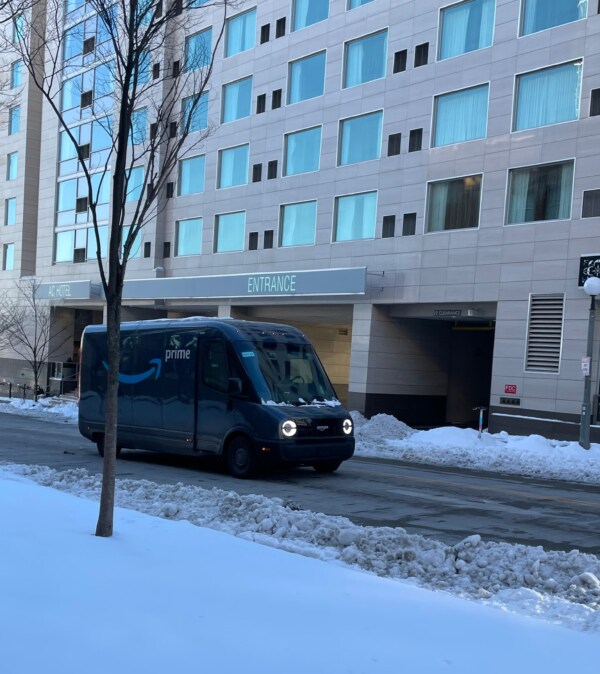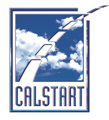Accelerating the Switch:
How to Carry Momentum for Zero-Emission Trucks Into 2025
By Jacob Richard

Rivian Amazon van delivering packages in Cincinnati, Ohio. Photo by Jacob Richard.
In the spring of 2024, I saw my first zero-emission truck (ZET) in the wild: a Rivian Amazon delivery van outside my downtown apartment in Cincinnati, Ohio. I did what any clean transportation advocate would do and sprinted to talk with the driver. He lauded the van’s range, ease of charging, safety, and overall driving experience. This impromptu interaction proved to be one of many I would have with ZET drivers throughout 2024—I now see a zero-emission delivery van in my neighborhood every day, even in freezing temperatures and record-breaking snow.
Despite executive orders adding uncertainty to industry-shaping awards such as the EPA’s Clean Ports Program and Clean Heavy-Duty Vehicles Program and forward-thinking approaches like the National Zero-Emission Freight Corridor Strategy, the progress and momentum for a ZE freight future generated in 2024 will continue into 2025. As reported in the latest Zeroing in on Zero-Emission Trucks market update, more than 42,500 ZETs are now deployed across the U.S. as of June 2024. These vehicles are eliminating emissions in the communities where they operate and successfully moving freight, especially in last-mile delivery but also in heavier applications: Volvo, Schneider, Motiv, and Nikola all made announcements of medium- and heavy-duty ZET models surpassing millions of miles driven in 2024. And ZET deployments are happening in both cold and warm climates and in areas across the political spectrum, with 16 states now having more than 1,000 ZET deployments. ZETs are capable of operating across the country today.
But the pace of deployments needs to double. In the first six months of 2024, ZET sales made up just 2.6% of overall truck sales. As we approach climate targets—such as those set out in the Global Memorandum of Understanding on ZE Medium- and Heavy-Duty Vehicles of 100% new ZE truck and bus sales by 2040, with an interim goal of 30% by 2030—it is apparent that, while all fleets still need incentives to purchase the vehicles and necessary infrastructure, the freight industry cannot rely solely on these incentives to spur market growth and alleviate barriers to adoption. Other critical action items to advance the ZE freight industry in 2025 include:
- Increase public infrastructure for ZETs. We anticipate the opening of several new public infrastructure stations in 2025, but ensuring that new stations are strategically located, operationally reliable, and effectively utilized will be critical to support ZET adoption. While most large fleets will utilize private infrastructure, many of their strategies also include relying on public or shared infrastructure. Shared charging sites, which are made available to more than one fleet, can both timely and cost-effectively scale public infrastructure. Fleets, both small and large, can effectively utilize shared charging for local, regional, or long-haul routes.
- Start implementing innovative financing solutions for ZETs. Upfront prices and lease payments remain high for ZETs and are still a major barrier to adoption. While incentives can help alleviate some of these upfront costs, sales tax and federal excise tax remain huge burdens for fleets. Every state that has adopted the Advanced Clean Trucks (ACT) rule should be looking to eliminate or reduce the sales tax for ZETs. Let’s start educating banks and lenders about the lower risks associated with ZETs. Working with OEMs to benchmark ZET depreciation can also help unlock more favorable and affordable financing for all fleets.
- Amplify the voices of carriers and shippers deploying this technology. There are more than 42,500 ZETs on the road across all 50 states, and yet mainstream publicity on this progress is rare. Both small and large fleets are deploying these vehicles, and their stories should be elevated to showcase the feasibility and benefits of ZETs. We should work to connect shippers who want to move freight with ZETs with carriers who have them, and provide space to listen and learn about what worked and what did not from those who have deployed ZETs. Early adopters help shape how we accelerate ZET adoption and provide a valuable voice for how to move forward.
These areas of focus will make it more practical to own and operate a ZET, reduce range anxiety among fleets, and give more publicity to the ZET success stories across the U.S. We urge you to consider these three actions and determine which you and your organization are best positioned to advance in 2025. Together, we can implement innovative projects to ensure ZETs are affordable for all fleets. Especially as fossil fuels continue to receive substantial subsides, restricting access to incentives at this time will hinder market momentum and slow progress toward achieving climate goals. Now is the time to help any fleet wanting to deploy ZETs do just that.
Jacob Richard is a technical project manager on the Trucks team at CALSTART and author of the new Zeroing in on Zero-Emission Trucks market update.
